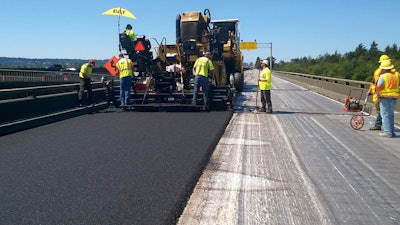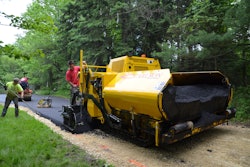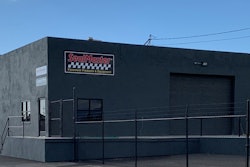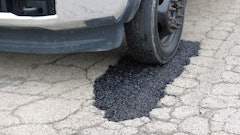
Washington residents can thank the climate for the lush green foliage, but roads and bridges don’t share their enthusiasm. The wet weather is a bane to the state’s travel infrastructure, plaguing the pavement with perpetual potholes and other problems. The state’s continued population growth (now 7.4 million*) also poses challenges, as vehicles crowd the highways, especially in metropolitan areas.
With the area’s average annual 90 days of sunshine, there are only brief opportunities for repairs. Making the most of the state’s funding packages (i.e., Connecting Washington, the “Nickel” Funding program, etc.) is imperative in supporting the transportation system and preserving critical infrastructure.
THE SITUATION
The westbound, three-mile stretch across the Crafco engineers tested and confirmed the GeoTac HS fabrics would sufficiently seal out moisture and debris without need for hot-mastic sealer if laid out with a larger, 4-in. overlap at the seams.Washington State Department of Transportation
Crafco engineers tested and confirmed the GeoTac HS fabrics would sufficiently seal out moisture and debris without need for hot-mastic sealer if laid out with a larger, 4-in. overlap at the seams.Washington State Department of Transportation
THE CHALLENGE
Having completed the eastbound paving a few years prior, WSDOT now solicited bids for its counterpart. The westbound project would be more complex, costing nearly $11.6 million for necessary repairs. The venture would include the application of 536,000 square feet of geosynthetics, one of the largest quantities used by WSDOT for a single waterproofing project. The DOT’s Standard Specifications for Road, Bridge, and Municipal Construction called for non-woven geosynthetic materials to exhibit 150 lb. min. tear strength (ASTM D4533), 200 lb. min. grab tensile strength (ASTM D4632), and 220 lb. min puncture resistance (ASTM D6241).
Project planning and design also would be  An up-close photo of a new layer of asphalt over waterproof matting. The matting keeps rain from seeping into the trestle's concrete and rebar structure.Washington State Department of Transportation
An up-close photo of a new layer of asphalt over waterproof matting. The matting keeps rain from seeping into the trestle's concrete and rebar structure.Washington State Department of Transportation
THE SOLUTION
Selected primary contractor, Lakeside Industries, had managed a number of paving projects for the state, partnering with Jonnic Construction to do the underlying waterproofing membrane. The crews would collaborate once again, facing the new challenges head-on.
Jonnic chose Crafco GeoTac HS, a high-strength, peel-and-stick waterproofing membrane composed of fully modified SBS asphalt mastic on non-woven polyester geotextiles. GeoTac HS is proven to seal out moisture from concrete or asphalt surfaces while dispersing stress associated with reflective cracking. In addition to providing a more rigid structure that makes it easier to peel, Crafco GeoTac HS achieves nearly twice the required ratings for all three WSDOT-required ASTM standards and those of competitor products.
A long-time customer, Jonnic also looked to leverage Crafco’s agile delivery network and tap its field engineering and troubleshooting support to ensure against any downtime.
With significant deterioration evident, the teams started by breaking up the existing asphalt with excavators, cleaning/blowing off the deck, and tearing off the old membrane — with shovels and by hand. With the surface prepared, the teams attached 55-gallon drums of Crafco Asphalt Primer to pumps, spraying evenly on the area. They then rolled out the 48-in. GeoTac HS across the center, managing the more meticulous edgework with 12-in. GeoTac HS rolls.
PAVING TO PERFECTION
While typical geocomposite installs require hot mastic A single lift of 2.5in. HMA was applied the morning after each shift, extending traffic lockout till it fully dried to ensure optimum results.Washington State Department of Transportation
A single lift of 2.5in. HMA was applied the morning after each shift, extending traffic lockout till it fully dried to ensure optimum results.Washington State Department of Transportation
Once installed, Jonnic used Lakeside’s pneumatic, rubber-tired asphalt roller already at the site to press the material down and eliminate bubbles. The uniformity of the Crafco geocomposite and this rolling process ensured a solid waterproofing base. A single lift of 2.5-in. HMA (the recommended minimum) was applied the morning after each shift, extending traffic lockout till it fully dried to ensure optimum results.
Now 66% complete, the US 2/I-5 Interchange to Bickford Avenue project has shut down for the winter. As weather permits, the teams will wrap up in the spring. As they begin, they will need to cut back the edges, re-prime, and do a GeoTac HS overlap to properly stabilize the new pavement joint connections with the pavement laid down before winter.
Because of its size and complexity, the US 2/I-5 Interchange to Bickford Avenue project will serve as a model for future WSDOT pavement preservation initiatives. Crafco GeoTac HS waterproofing membrane is expected to dramatically reduce long-term maintenance costs and extend service life. More important, it will provide the foundations for a thoroughfare that allows safer travels for residents of the Evergreen State and improved quality of life.
*State of Washington 2018 Population Trends, State of Washington Office of Financial Management, July 2018.











![Lee Boy Facility 2025 17 Use[16]](https://img.forconstructionpros.com/mindful/acbm/workspaces/default/uploads/2025/09/leeboy-facility-2025-17-use16.AbONDzEzbV.jpg?ar=16%3A9&auto=format%2Ccompress&fit=crop&h=135&q=70&w=240)








